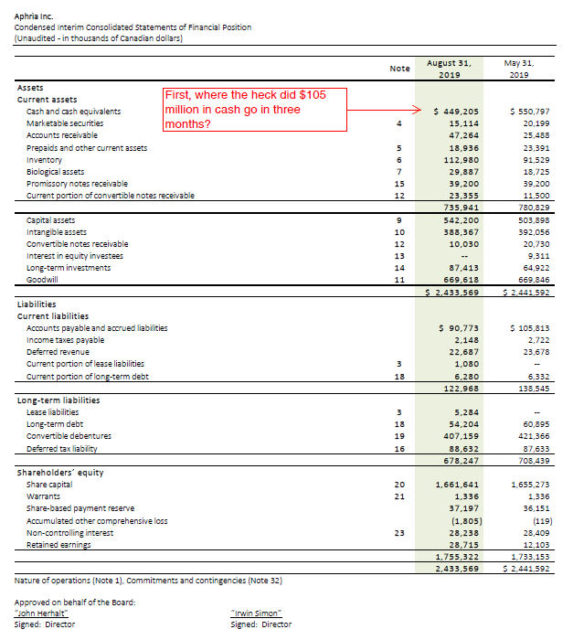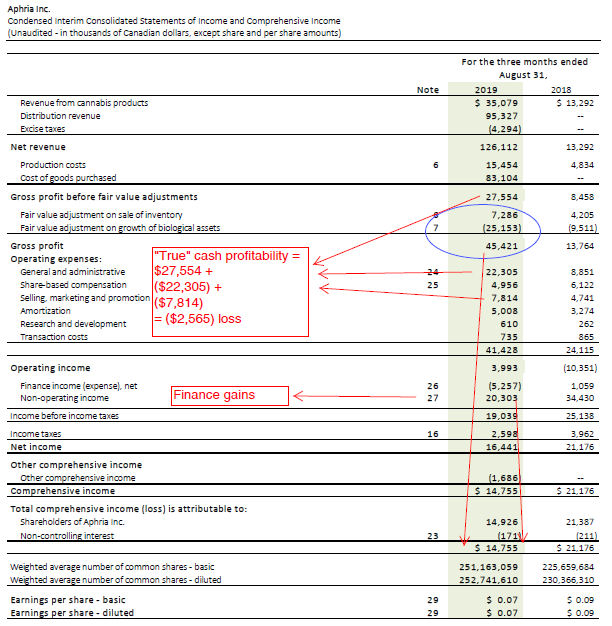I couldn’t resist looking at the financial statements of Aphria (TSX: APHA) since I observed the marijuana sector today has received quite the bid. Today Aphria released their quarterly results and with the following by-line:
Aphria Inc. Announces Second Consecutive Quarter of Profitability and Positive Adjusted EBITDA
Looks good, right? There’s a lot of retail investors in these marijuana stocks, and most of them don’t read the detailed financial statements.
So when glossing over them, I notice this is a textbook case of “announced profits and positive adjusted EBITDA does not mean the company is making money”. Let’s dive further – this is a pretty good case study for beginning investors to learn how companies manage to put the most positive spin on their financial statements.
Look at the cash.
We look at the balance sheet to start with. The first red flag comes in the form of the very decreased cash+marketable securities balance. Sometimes in companies they have to invest initially (e.g. property, plant, equipment) in order to make money. Sometimes companies have large debt payments.
In this case, roughly $22 million went to accounts receivables. Normally receivables should correlate with revenues, but in this case, APHA’s Q1-2020 net revenues ($126 million) were actually LOWER than Q4-2019 ($129 million). Uh-oh…
Inventories and biological assets went up $21 million and $11 million, respectively. (Notes 6 and 7, which we will dive into below).
Capital assets went up $39 million.
All of this accounts for about $93 million of the $105 million cash burn. The rest of it, while interesting, I will disregard for the rest of this analysis – it isn’t the bulk of what’s happening. We’re trying to figure out where the cash is going.
Note 6, inventory:
I will give an example of what is going on here. Just looking at “Harvested cannabis”, the company spent $15.5 million to harvest this. “Capitalized cost” means they converted it into inventory using cash, without it being considered an expense. The “Fair value adjustment” of $20.3 million is management deciding that the value of the harvested cannabis is that much higher, and it can be reflected as such on the balance sheet. The process of doing this is a gain on the income statement, which I will show later.
The questions at this point is whether:
a) Is this estimate accurate? I have no idea.
b) Can the company actually sell this harvested cannabis at or greater than the adjusted value of $35.8 million?
Accounting-wise, inventories are governed by the rules of IAS2, which roughly states that inventories are kept at the lower of cost or net realizable value. These products are distinct from the biological assets, which are governed by IAS41.
Note 7, biological assets:
The key lines here are “Changes in fair value less costs to sell due to biological transformation” and “Production costs capitalized” for $25.2 and $29.8 million, respectively. This is effectively the company deeming that their growing process is facilitating an increase in value of their inventory when it is eventually transferred to that column, but in order to realize this, they need to sell the product!
Note 9, capital assets:
This actually looks reasonable. The company spent $37.9 million on production facilities, equipment, and construction-in-progress, which makes sense if you are a marijuana producer. The quantum of expense can be debated, but the nature of these types of expenses appear in-line with the type of business they are engaged in.
So how does APHA claim profitability?
This dog’s breakfast of an analysis of the income statement drives a couple points:
1) The claimed profits are primarily on the basis of the fair value adjustments through Notes 6 and 7 in the financial statements (to the tune of $17.9 million)
2) And some finance gains on Note 27 (I will not bother getting into this).
In reality, the company is blowing a lot of money on inventory. It is very difficult to take the assertions of profitability seriously unless if you believe that the stated fair value gains on the inventory and biological assets are real and can actually be realized with real sales at the stated values.
I give no valuation opinion at this time other than to state that at $7.10/share (or $1.8 billion market capitalization at 252.7 million diluted shares outstanding) I am not interested in buying.
It took me about 5 minutes to gloss through these financial statements, but about an hour to present it in the very hurried form above. If I spent a couple extra hours, I could have really polished up the presentation, but this was enough for me. If you found this at all useful, please let me know.





Yes, for the newbie like me it was interesting.
Would love to see more analysis like this for different companies across different sectors.
Thank you!
I have a question though.
In Aphria’s Note 14:
“The Company owns 11,344,505 common shares in NAC (National Access Cannabis) at a cost of $11,574, with a fair value of $4,992 as at August 31, 2019.”
NAC price was ~$0.31/share on August 31, 2019, so 11,344,505*0.31 = ~$3517k
What do these “cost” and “fair value” mean then?
Thank you!
Said stock was not $0.31 on August 31st. On Friday, August 30th, the stock closed at $0.44. (Source if you need it: https://web.tmxmoney.com/quote.php?qm_symbol=META&locale=en).
Therefore 11,344,505 shares multiplied by $0.44 share price equals $4,991,572.20.
Seems you just are using the wrong share price.
Yep, thank you! My price was in USD somehow.
Then $11,574 is what they actually paid for these shares, ie they are deeply underwater, right?
Yes. Dividend the cost they list by the the number of shares owned and you’ll get what Aphria paid for them, so roughly $1.02 a share. Looking at the stock chart, it looks like that is pretty close to the exact top, so well done Aphria!
Good stuff
Not a sector I invest in, but very much enjoyed and appreciate the post Sacha…”keep em comin”
Looks like Tyler saved me some time to reply. Thanks Tyler, and to the rest for commenting. I’m debating whether to actually open up a Youtube channel to do this sort of thing, since I suspect it may be easier to present.
I prefer reading than watching videos, much easier to navigate the content (skip some parts, or re-read) and use it (copy/paste, links).
Videos are for consuming, not for thinking.
But, whatever you chose, thanks anyway! 🙂
I think that’s a good idea. Worth a try anyway. I like the “forensic” accounting posts very much. So would love to see you keep doing them.
I’ve also got to de-lurk long enough to express my love for accounting/analysis posts like this!
Thank you everybody (and Potato for coming out of his lurking) for chiming in. I hardly look at the web statistics on this site anymore (it’s flooded with spam bots, etc.) and hence having human beings write like you did is gratifying.
Found it useful! I would appreciate more of these accounting analysis posts; especially ones that focus on highlighting a company’s true cash generating abilities (hint: ATP). The related info on IAS rules is also very helpful when you can see them applied to a specific company situation. Thanks!
As for web statistics, I appreciate and read the articles once they pop into my email inbox. Not a bot!
ATP is pretty easy to model. When their power plants are not erupting into flames, their plants are generating very healthy amounts of cash, but this is because their power purchase agreements were struck at the era when such agreements were quite lucrative. Their free cash flows will primarily be used to chip away at their credit facility and this will put them in a pretty good position in a few years where they will be earning less cash flow than today, but their de-levered balance sheet will give them ample breathing room. I think the existing management saved the company.